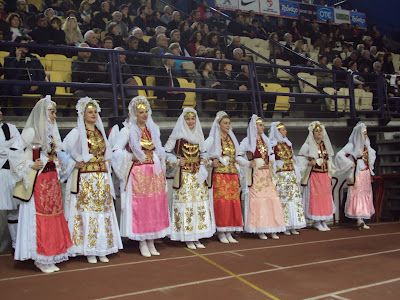Hello all,
Today I will continue my series on the costumes of North Epirus with an overview of the area. I have written dedicated articles about the costumes of Dropoli / Dropull and Pogoni / Pogon, but I do not have sufficient information about the rest of this region to do more individual articles. Dropoli and Pogoni are basically completely inhabited by Greeks, but the rest of this region is much more ethnically mixed, with Greeks, Albanians and Vlachs all being found to various degrees.
https://en.wikipedia.org/wiki/Greeks_in_Albania
I will be focusing on those areas with a significant Greek Presence, but many of these costumes are also worn by Tosk or Lab Albanians. I will proceed from West to East. For aomw of these regions, I have found little information.
Vlorë County
https://en.wikipedia.org/wiki/Vlor%C3%AB_County
Χειμάρρα, Himara, Himarë
https://en.wikipedia.org/wiki/Himar%C3%AB
This town with some surrounding villages forms an ethnically Greek island surrounded by Albanians. It is found on the coast some 50 km north of Sarandë. The nearby villages of Dhërmi, Palasa, and Qeparo are inhabited fully or partially by Greeks as well.
This region is also famous for polyphonic singing.
https://www.facebook.com/reel/305185569200327
https://en.wikipedia.org/wiki/Delvin%C3%AB
This town has a substantial Greek minority. For this, and many of the following regions, there seems to be no difference between the Greek and Albanian folk costumes.
Φοινίκη, Foiniki - Finiq
This municipality has a majority Greek population. The name is also Greek.
https://en.wikipedia.org/wiki/Finiq
Μεσοπόταμος, Mesopotamos - Mesopotam
This region obviously has a Greek name, and a significant Greek Population. It lies a few km east of Foiniki.
Δίβρη, Dibri or Divri - Dhivër
https://en.wikipedia.org/wiki/Dhiv%C3%ABr
Gjirokastër County
https://en.wikipedia.org/wiki/Gjirokast%C3%ABr_County
Δρόπολη, Dropoli - Dropull
https://en.wikipedia.org/wiki/Dropull
This is a majority Greek region. I have already done an in depth article on this region.
https://folkcostume.blogspot.com/2024/09/folk-costume-and-embroidery-of-dropoli.html
Google is mistaken about the extent of this region, in fact, it extends south to the Greek border.
Πωγώνι, Pogoni - Pogon
https://en.wikipedia.org/wiki/Pogon,_Albania
This region is split by the border, there being about 45 villages on the Greek side, plus 7 on the Albanian side that are inhabited by Greeks. I have also done an in depth article on this region.
https://folkcostume.blogspot.com/2024/09/folk-costume-of-pogoni-epirus-greece.html
Αργυρόκαστρο, Argyrókastro - Gjirokastër
https://en.wikipedia.org/wiki/Gjirokast%C3%ABr
This is an urban center. This area was contested between Greece and Albania for some time. The majority population today is Albanian, but there is a substantial Greek minority, and a sizeable population of Vlachs as well. The costume is of the urban Ottoman type, and seems to be worn by all.
Note that the white cap is a symbol of an Albanian man. It would not have been worn by Greeks or Vlachs.
Λιούντζη, Liountsouria - Lunxhëri
https://en.wikipedia.org/wiki/Lunxh%C3%ABria
This region is predominantly Albanian, but has Greek and Vlach minorities. The folk costume is exceptionally rich, reflecting the fact that the men of the region traditionally spent much time abroad in foreign trade. The image at the head of the article is of this costume. Again, the costume seems to be worn by both Greeks and Albanians.
.png)
Ζαγόρια, Zagori - Zagori and Ρίζα, Riza - Rreza
These two regions lie next to Liountsouria - Lunxhëri, Zagori to the east, and Rreza to the north. I have been unable to find much information about this area. Wikipedia states that Zagori is mostly Albanian, with some Vlachs. However, it has no information on Riza - Rreza. Google maps show Greek Orthodox Churches in the Riza - Rreza area, however, as well as in the village of Zhej in Zagori. This Zagori is not to be confused with the region of Zagori in Greece.
Zagori
These two images are from the village of Zhej in Zagori.

.svg.png)








.png)







.png)















.svg.png)
.png)









.png)





.png)
.png)












.png)











































it is very good to be here of it in the very well of it to be here of it to be one of them to be here
ReplyDeleteLovely!
ReplyDelete